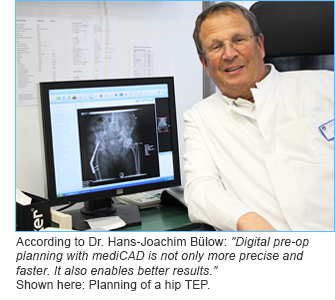



Published, 29.08.2022
German Army Hospital in Ulm uses mediCAD
Digital planning opens new doors
Digital planning of orthopedic operations is commonly associated with the ability to generate revision-proof documentation. This capability is a major advantage over earlier planning methods with templates and radiographs, which then had to be archived in paper form. The German Army Hospital in the city of Ulm has been using the mediCAD Classic® digital planning solution from Hectec GmbH for about four years. In addition to the benefits of secure documentation, the hospital has discovered numerous functional advantages of using this software.

Dr. Hans-Joachim Bülow at the Department of Trauma Surgery and Orthopedics mentions preservation of the joint line during total endoprosthesis of the knee joint as just one example. “With digital planning, the joint line remains intact. In the past, this was not possible.” Shifted joint lines lead to instability, pain in the anterior knee, and limited flexion.
Instead of defining the knee joint line during the operation with rough approximations like “two-fingers wide superior to the tibial tuberosity”, “20 mm superior to the fibular tip“, or “at the lower pole of the patella during extension”, digital planning precisely indicates the joint line without approximation. The axis is measured at exactly 90 degrees; even adjustment to the original anatomical angle can be performed reliably.
Faster and more precise planning
This example demonstrates a major advantage of digital pre-op planning: It is significantly more precise and gives the patient greater confidence in an optimal outcome. Other examples include precise planning of implant offsets on hip TEPs, equalization of leg lengths during osteotomies of the lower extremities, and a freely selectable height for each center of rotation. In these cases, both the angle and size are planned with high precision, facilitated by a reference sphere that is depicted on the screen. According to Dr. Bülow: “Deviations are never greater than one size, which is a tremendous help to us. mediCAD® saves us lots of time in many different ways. Time savings are the greatest during corrective osteotomies, at about 60%.” In addition to the determination of the height and the center of rotation, indication of the angle is of great benefit for corrective osteotomy. The surgeon recognizes immediately if the angle is larger or smaller than anatomically necessary. “This lets us eliminate problems that may otherwise result in post-operative arthrosis.”
Database of implants saves time
The database of implants is an integral part of the solution and contributes significantly to the time savings. With approximately 450,000 templates in all sizes from 105 international manufacturers, it is the largest database of its kind. hectec expands the database every month with new and additional implant systems. In the rare instance that an implant is missing, they add it to the database at no charge. With the database as a reference, simulating several variations of an operation with a variety of implants is very straightforward, making it easy to find the best possible solution. Simulation can even be performed immediately before an operation if new information becomes available or when prep time is very short. One minute is enough time to simulate a hip TEP; a knee TEP with joint line, a femoral head, and determination of the longitudinal axis require about five minutes. In the experience of the German Army Hospital, planning is highly precise in all situations.
Launched jointly with PACS
With the introduction of digital radiography and the Cerner PACS, the hospital was no longer able to use template-based planning, requiring them to switch from analog to digital planning. Before selecting mediCAD®, the hospital consulted with similar institutions about their experiences with various digital solutions. In addition to this feedback, other factors like the extensive database of implants, precise reproducibility of each plan, and the ability to plan both quickly and precisely influenced the hospital’s selection of mediCAD®.
On average, the hospital uses digital pre-op planning approximately 300 times per year. About 250 operations are TEPs and about 30 are corrective osteotomies.